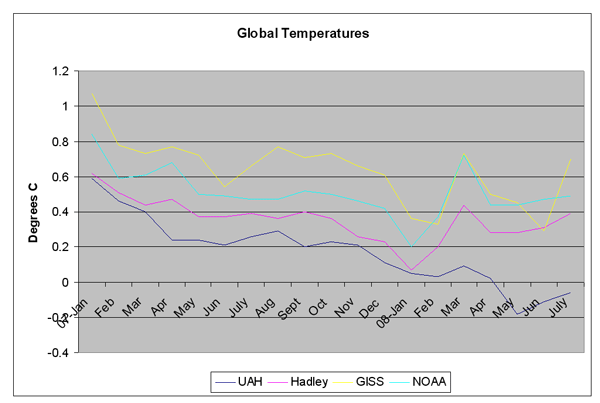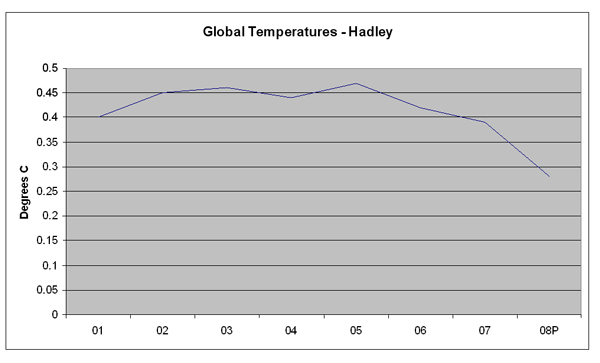Who has noticed that the period 2014-2015 keeps on turning up in the debate on greenhouse science? For that is when greenhouse proponents say the long-delayed global warming apocalypse will start happening. In addition, that general date has turned up in forecasts made by an arch sceptic, and two researchers in the US have forecast that sunspot activity will cease entirely by 2014.
As the two sides do not agree on anything else at all this is odd - odd enough to be worth exploring.
One group to point at the 2015 date is led by Noel Keenlyside of the Leibnitz Institute of Marine Science in the German city of Kiel. As reported in the journal Nature (letters, May 1) Keenlyside and colleagues added the affect of climate cycles to the Intergovernmental Panel on Climate Change models to forecast that global temperatures will remain stable or perhaps even dip down for the next few years, before heading up. The paper does not give a date for the expected kick up in temperatures but in a subsequent interview with the Daily Telegraph in the UK Keenlyside stated that the earth will start to warm again in 2015.
Advertisement
Keenlyside was forecasting from his research into the powerful Atlantic meridional overturning circulation (AMO) climate cycle which, he says, has a global effect and will weaken to its long term mean. He also emphasises that his work in no way contradicts that of the IPCC - he is merely adding climate cycles on top of the panel’s predictions - but his work seem to have horrified the hardliners. There have been internet reports that prominent scientists have tried to challenge the Keenlyside team to bets on temperature trends. However, other climate cycles seem to be following the AMO lead. In April, NASA announced that the Pacific Decadal Oscillation has shifted from its warm mode to its cool mode - a switch that will not be discussed here but may also result in significant cooling.
More recently, another group observing the sun has also come up with the date 2014 but for quite different reasons. As has been noted a few times in the media, the sun has gone quiet - too quiet - with the next solar cycle so far not putting in an appearance. Scientists have known for a very long time that the earth has a distinct 11-year cycle. At its height, indicated by lots of sunspots, the sun is very active giving off lots of flares and solar storms which affect satellites. At the bottom of the cycle there are few or no spots, and a marked lack of activity.
The last cycle was officially declared over by NASA in March 2006 with one group at the space agency putting out a release confidently forecasting that the next cycle would be 20 to 50 per cent stronger than the old.
The sun responded to this piece of scientific hubris by going quiet. A few spots from the new cycle have been sighted, as well as a few spots from the old - scientists can tell which spots the cycle belongs to by their magnetic polarity - but very little has happened.
At the time of writing the sun is still spot free. NASA solar physicist David Hathaway points out, quite rightly, that the sun’s behaviour is within major statistical limits - just. The average solar cycle lasts 131 months plus or minus 14 months and the current cycle - the quiet period counts as part of the old cycle - has lasted nearly 143 months. The solar cycle went quiet for years at the beginning of last century before restarting, Hathaway notes, so nothing out of the ordinary has happened - at least, not yet.
Another group at the US National Solar Observatory in Tucson, Arizona, William Livingston and Matthew Penn, believe that there may be a deeper process at work. Sunspots are highly magnetic regions that are somewhat cooler than the rest of the sun’s surface (they appear dark compared to the rest of the sun, but if seen separately would appear very bright) and the two researchers have been tracking both the temperature and magnetic strength of the spots. They found that the spots have been warming up and becoming less magnetic. An average of the trend is a straight line going down which hits the bottom of the graph at 2014. They have concluded that, although sun spots may appear briefly from time to time in the next few years, they will disappear by 2014.
Advertisement
This conclusion is in a paper submitted to the journal Science three years ago but rejected in peer review. With the sun now so quiet the paper has been resurrected from a filing cabinet in the observatory and circulated informally. Dr Livingston told me (by phone from his office in Tucson) that the paper had been rejected on the grounds that it was a purely statistical argument so it would be better to wait and see what happened, and he considered that a fair point. They are now waiting “for the right moment” to resubmit.
But what happens after 2014? Dr Livingston says that as they are using a purely statistical argument, without any theory to back it, they do not know. All they know is that the trend reaches zero in 2014. Conventional theory on the sun’s inner workings never forecast anything like this - in fact, forecast the exact opposite - but has been revised to say that the sun will restart some time next year.
With the sun being quiet for a surprisingly long time, plenty of commentators are pointing to the possibility of a Maunder Minimum - a period from 1645 to 1715 with very few sunspots which is associated with a series of bitter winters known as the Little Ice Age. Although it is widely acknowledged that there must be some link between the sun’s activity and climate, the nature of the link and its effectiveness is hotly debated. The IPCC models, the ruling orthodoxy, gives star billing to the effect of industrial gases in the atmosphere and places solar variations in the also ran category. However, as we shall see those models have proved largely useless for forecasting - in the short term, at least - and there are no rival climate theories. The sceptics largely decline to forecast, pointing out, with some justification as it turns out, that there is as yet no means of forecasting what the sun will do.
One sceptic who is prepared to make a forecast, and who also points to the date of 2015, is professional UK weather forecaster Piers Corbyn. The bulk of scientists have little time for Corbyn, who is a strong advocate of the link between solar activity and climate. Greenhouse proponents, in particular, detest him. For as well as stridently denouncing the IPCC whenever he can, he also appeared on the documentary The Great Global Warming Swindle. However, he does have a track record as a weather forecaster and, for whatever reason, is saying the same things as the Keenlyside team, at least for the next few years. He forecasts that global temperatures will decline until 2015, and then kick up briefly, before declining again.
Whatever you may make of all this forecasting, a major problem remains working out what is happening right now, for the centres that track global climate say different things. There are five sites that I know of. Anyone who can think of others can message me on mlawson@afr.com.au. Of those five, three are instrument centres - relying on networks of ground stations and ships for temperature readings - and two are centres that use satellites to track temperatures. They are listed below, along with links to the data used in the graphs at the end of the article.
Hadley - Generally regarded as the most authoritative of the instrument centres. The Australian Bureau of Meteorology site links to the temperature tracks on the Hadley site. It is a part of the University of East Anglica in the UK and associated with the UK Meteorological Office, which are both IPCC bastions. The graphs use HADCrutv3.
GISS - Goddard Institute of Space Studies. A part of NASA. The director of this instrument centre is arch greenhouse spruiker Professor James Hansen. Greenhouse proponents always quote this centre’s temperatures for the annual results from this site are mysteriously higher than the others. Data for the graphs is here.
NOAA - National Oceanographic and Atmospheric Administration. Owned by the US Department of Commerce it is an instrument centre. Link for data here.
UAH - University of Alabama in Huntsville. A satellite centre run through the Earth System Science Centre. Director Dr John Christie is sometimes cited as a greenhouse agnostic, although he has contributed to several IPCC reports. The centre has shown temperatures trending down for years. Link here.
RSS - Remote Satellite Services. The site for this centre makes little sense to the laymen but from the graphs presented by scientists who have dealt with it, RSS surface temperature results are broadly similar to that of the UAH. I could not find any public access data for surface temperatures.
There are two graphs, produced using Excel. One is for temperature readings from four of the sites from January 2007 up to August and the other is for Hadley, as the mostly widely accepted, from 2001. As the IPCC third report was released in 2001 and the fourth report was released in February 2007, this should give us some idea of the forecasting success of the models. An interesting point in all of this is that NOAA and Hadley more or less agree (the difference is probably a difference in the base line the two sites use) but GISS shows a somewhat warmer world and the satellite results are markedly cooler than the others. However, none of the centres can point to anything but failure for the IPCC. There is still time for actual temperatures to bounce back to somewhere within the model forecasts but in the short term, at least, and on the only test that really matters for computer models - forecasting what was not known at the time of the report - the models have generally failed.
Given the track record of the existing models, and instead of generally rejecting the proposal that temperatures will remain subdued until 2015, greenhouse proponents should embrace the forecast - it is likely to be more accurate than any of the others made to date, particularly given the lack of solar activity. And we should all hurry towards 2014-2015 as fast as we can, to find out what happens.

